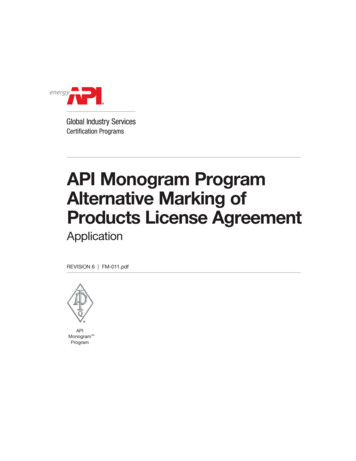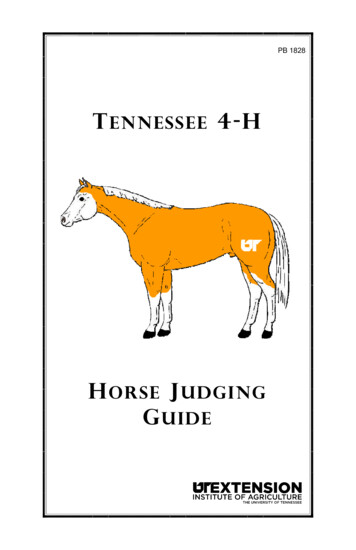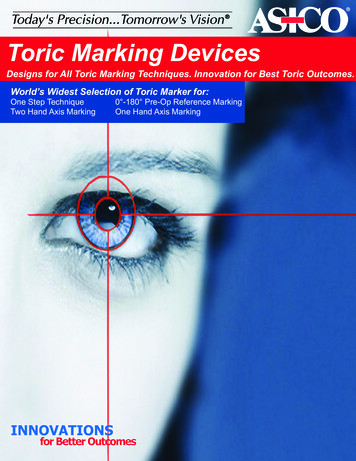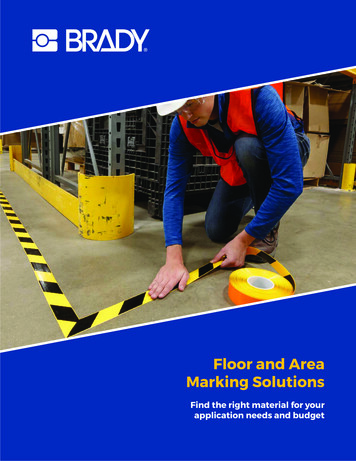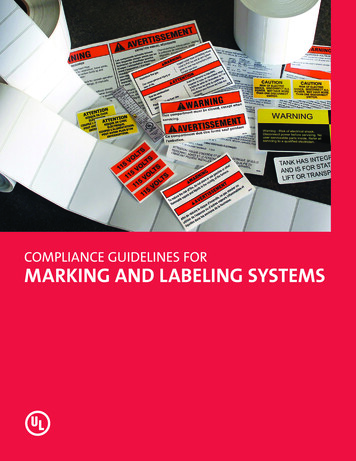
Transcription
COMPLIANCE GUIDELINES FORMARKING AND LABELING SYSTEMS
Compliance Guidelines for Marking and Labeling SystemsMost electrical products and equipment are required to be marked with specific safety-related information andmeet permanency of marking requirements. These markings can include electrical ratings, use instructions, warningsregarding potential safety hazards, and cautionary markings. Compliance with permanency of marking requirementshelps ensure that the labels will adhere to the application surface, and that the text will remain legible for theproduct’s intended use.This UL white paper discusses the specifics of marking and labeling requirements, and how to identify compliantmarking and labeling systems for use by product and equipment manufacturers. Beginning with a definition ofmarking and labeling systems, the paper will then briefly review the testing and evaluation protocol required undercurrent marking and labeling standards. The white paper then discusses the process for sourcing compliant markingand labeling systems, and concludes with recommendations for both end-product manufacturers and label convertersand printers.What Are Marking and Labeling Systems?Labels (also referred to as nameplates or markers) convey a wide range ofinformation regarding the safe installation or use of a given product. Forexample, information about a product’s electrical rating can help confirmcompatibility with an electrical system or other product, thereby preventingcircuit overloads or product failures. Other information can warn usersabout the risk of electric shock under certain operating conditions such asproximity to water or sources of moisture. In other cases, labels can providethe user with information about appropriate use environments, e.g., “forindoor use only” or how to properly use the product.Government regulations, codes such as the National Electric Code andproduct safety standards, as well as many distributors and retailers, oftenstipulate that products need to meet applicable safety requirements. Theseproduct requirements usually prescribe requirements for the permanence ofmarkings when a label is being used to convey safety-related information,including hazards, warnings, cautionary markings, installation instructionsand electrical ratings. Even in cases where safety standards don’tapply, original equipment manufacturers (OEMs) often specify markingperformance requirements to their label suppliers. At UL, these types oflabels are referred to as “marking and labeling systems.”page 2
Compliance Guidelines for Marking and Labeling SystemsStandards that Address the Permanence of MarkingWhether mandated by regulations, codes, retailers or manufactures themselves, specific permanence of markingperformance requirements are often required for products such as appliances, consumer electronics, motors, lighting,medical equipment, and more. There are a number of permanence of marking standards for labels, but two of the mostwidely referenced are ANSI/UL 969, the Standard for Safety of Marking and Labeling Systems, and CSA C22.2 No. 0.15,Adhesive Labels. ANSI/UL 969, Marking and Labeling SystemsUL 969 was first published in 1978 and is considered the de facto performance standard for durable safety labelrequirements around the world. UL 969 is referenced in over 450 UL and over 30 ULC end-product standards, and ismentioned in ASTM, NFPA, ANSI, and manufacturer specifications, making it the most widely referenced label standardin the supply chain.UL 969 covers adhesive attached labels (pressure sensitive, heat activated or solvent activated) and in-mold labels foruse as permanent nameplates or markers, that provide information, instructions or identification in the form of textor pictographs. The Standard outlines specific criteria regarding the permanence and legibility of the labels as well as thetest procedures required to determine compliance. Under the Standard, labels are evaluated as complete “systems,” e.g.,overlamination, ink and stock, on specific surface materials for use in dry indoor environments, indoor environments inwhich a label may be exposed to water or high humidity, or outdoor environments. Additional environmental conditions,such as exposure to oils, detergents or gasoline, can also be evaluated. Since most safety standards and manufacturersreference UL 969 requirements, labels found to meet the requirements of this Standard are considered suitable for usewith a wide range of products, greatly reducing testing and supply chain complexity. CSA C22.2 No. 0.15, Adhesive LabelsCanadian Standards Association (operating as “CSA Group”) standard C22.2 No. 0.15 was first published in 1990 andcovers the performance requirements of labels used for products evaluated to CSA standards. It has a similar scope to UL969 and also covers testing procedures and performance requirements of labels. However, the CSA and UL standards arenot harmonized, and the test methods, conditions, and performance requirements presented in the standards differ. Label Requirements of Other StandardsSome safety standards have chosen to utilize their own label performance requirements instead of a globallyrecognized standard like UL 969. Examples of these standards include ANSI portable ladder standards, UL 299 fordry chemical fire extinguishers and IEC-based standards. In other cases, safety standards may cover requirementsfor labels used as tags that are securement-strap attached, flag type, or wrapped around a cord or hose. In thesespecialized cases, the product safety standard has specific requirements that differ from typical products; therefore,labels used in these instances are required to be evaluated against the specialized performance requirements ofthe particular product standard.page 3
Compliance Guidelines for Marking and Labeling SystemsTesting and EvaluationThe evaluation for marking and labeling systems includes both a construction examination and testing forpermanence. The test program involves evaluating the performance of each system on an actual or representativeend-product surface after being subjected to environmental conditions that simulate the conditions that would beencountered in the label’s intended use, e.g., indoor, outdoor, etc. Construction ExaminationThe construction examinationis used to verify and documentthe construction of the labelbeing evaluated. It involvesidentifying the different layersof the label and their thickness,and confirming whether the labelincorporates an overlamination,varnish or support stock. Theconstruction examination alsoidentifies the layer or layers towhich the ink is applied, i.e.,top-surface or sub-surface, andconfirms the generic type of labelstock employed, e.g., paper orpolymer-based. UL 969 and othermarking and labeling standardstypically specify only performancerequirements and do not mandatethe use of specific label materials. Testing for PermanencyUL 969, CSA C22.2 No. 0.15, and most other marking and labeling standards utilize environmental conditioning oflabels prior to their evaluation for label permanency. After applying label samples to the actual or representativetest surfaces, the labels are conditioned in various exposures, such as water immersion, elevated and loweredtemperatures, chemical immersions, and ultraviolet (UV) weathering. After environmental conditioning has beencompleted, label compliance is determined by visually examining the samples for evidence of curling, wrinkling,shrinkage or loss of adhesion around the perimeter. Compliance also typically includes an evaluation to assesslegibility, resistance to defacement and minimum adhesion performance. Depending on the set of environmentalconditions to which label samples have been subjected, labels are then deemed suitable for the application surfaceunder those conditions.page 4
Compliance Guidelines for Marking and Labeling SystemsIEC-based standards typically require compliance with a marking durability rub test. This test involvesrubbing label samples with a cloth soaked with one or more liquids, such as water, petroleum spirit (hexane),methylated spirit (ethyl alcohol denatured with methanol), isopropyl alcohol solution or other liquids, andthen visually examining the label samples for legibility and adhesion. The choice and sequence of the liquidsto be applied and the duration of rubbing vary among IEC standards that include “Durability of MarkingRequirements.” Compliance is determined by visually examining the label samples to confirm print legibilityand that excessive curling/uplifting of the label edge has not occurred.page 5
Compliance Guidelines for Marking and Labeling SystemsSourcing Compliant Marking and Labeling SystemsUL maintains a comprehensive online database (http://iq.ul.com/labels) that allows manufacturers to searchfor UL Certified Component marking and labeling systems (often referred to as Recognized Components) thathave been tested and evaluated by UL. The database lists over 1,400 companies offering more than 30,000 ULRecognized Component marking and labeling systems, and provides an easy and convenient way for OEMs toidentify and acquire labels that meet the performance of marking requirements applicable to their productswhile helping to reduce the need for duplicative testing and surveillance of commercially available labels. Thedatabase also serves to strengthen supply chain integrity, since all Recognized marking and labeling systems fallunder UL’s Follow-Up Service (FUS) program, and are regularly verified for their continued compliance with UL’srequirements through periodic factory inspections at the label manufacturer’s facility and sample testing.UL certifies marking and labeling systems under five different categories, PGDQ2/8, PGJI2/8, PGGU2/8, PGIS2 andPGIM2/8, based on the type of label product and the end-use application (see Table 1 for additional details on eachcategory). Individual component listings in UL-maintained directories (also referred to as “yellow cards”) providedetailed conditions of acceptability. In the case of marking and labeling systems, the conditions of acceptabilityinclude application surfaces and the associated minimum and maximum exposure temperatures, use conditions(indoor or outdoor), and any additional chemical agent exposures. Other relevant information may also be available,such as suitability for end-user printing at OEMs and the specific inks that may be used to produce such printing.MARKING & LABELINGCATEGORIESPGGU2/8PGJI2/8 STOCKS (FILM, PAPER) ADHESIVES INKSLabel MaterialManufacturersPRODUCTS SOLDpage 6 Blank labelstocksPGDQ2/8, PGJI2/8PGIS2, PGIM2/8LabelConverters/Printers Printed labels Laminatingadhesives OverlaminatesOEMS(End-productManufacturers) Finishedproducts(with appliedlabels)
Compliance Guidelines for Marking and Labeling SystemsIn addition to the UL database, UL also provides additional guidance on the proper use of marking and labelingsystems through its online guide information. The guide information describes the intended use, conditions ofacceptability and requirements applicable to each certification category as well as the appropriate certificationmark to be used by the label supplier. As such, the “yellow card” and guide information provide invaluableinformation in determining the appropriateness of a given marking and labeling system for its application in aspecific end product.product typeproduct descriptionfabricated g & LabelingSystemsCovers printed labels that are manufacturedby a label printer/converter. They are notintended to receive additional printing byend-use product manufacturers.These products are soldas die-cut, finishedprinted labels.UL 969PGDQ2Guide InformationCSA C22.2 No. 0.15PGDQ8Guide InformationMarking & LabelingSystems – PrintingMaterialsCovers printed labels and unprinted stocksthat have been evaluated to receive additionalprinting by end-use product manufacturersusing simple printing equipment, includingthermal transfer. Additional printing inks forwhich the labels have been found compatibleare specified in the Recognition. Additionalprinting is considered an optional process forprinted labels.These products are sold bylabel material suppliers in bulkroll form or by label printer/converters as die-cut labelsthat are blank or preprintedwith blank areas in whichinformation is to be added.UL 969PGJI2Guide InformationCSA C22.2 No. 0.15PGJI8Guide InformationMarking & LabelingSystems – In-MoldCovers printed in-mold labels that aremanufactured by a label printer/converter andare intended to embed into a molded plasticpart during the molding process.These products are soldas die-cut, finished printedin-mold labels.UL 969PGIM2Guide InformationCSA C22.2 No. 0.15PGIM8Guide InformationMarking & LabelingSystems – MaterialsCovers materials that are used to makelabels. Products in this category includeblank label stocks, laminating adhesives andoverlaminations. This category is intended foruse by label printers/converters, not OEMs.These products are typicallyproduced in bulk sizesand sold to label printers/converters for the productionof labels.UL 969PGGU2Guide InformationCSA C22.2 No. 0.15PGGU8Guide InformationMarking & LabelingSystems – Limited UseCovers limited-use labels, cord tags (securement-strap attached, flag type, wrap-around)and placards that have been evaluated forcompliance with requirements in specificend-product standards where performancerequirements are either less stringent ordifferent than those in UL 969. Label use islimited to the types of products coveredby those end-product standards only.These products are sold asdie-cut, finished printedlabels, cord tags and placards.VariesPGIS2Guide Informationnotes:Guidelines addressing the suitability of the label when used with an end product are included online and generally cover application surfaces,temperature ratings, and additional exposure conditions for which the label was found acceptable. Labels evaluated to UL 969 under PGDQ2,PGJI2, PGIM2 and PGGU2 may have additionally been evaluated for specific end-use applications – including IEC marking of durabilityrequirements and fire extinguishers.Table 1: Marking and labeling systems summary tablepage 7
Compliance Guidelines for Marking and Labeling SystemsGuidelines to Reading the “Yellow Card”Published Certifications for marking and labeling systems follow a similar appearance across all the product categoriesstarting with basic information about the supplier, product designation, and label type at the top, followed by detailedconditions of acceptability below. It is important to note that published Certifications for marking and labelingsystems indicate suitability for use on generic application surface types, e.g., aluminum, polypropylene, etc., andnot to specific grades or suppliers of these surface types. This approach affords OEMs great flexibility in selectinglabels suitable for use on their product. In addition, it should be noted that the marking and labeling systems guideinformation specifies that the labels were not investigated to receive additional printing using hand implements, suchas a pen or pencil, as that process is not considered suitable for presenting safety-related information.Figure 1 illustratesa typical format forpublished Certificationof a printed label undercategory PGDQ2, whichcovers finished printedlabels evaluated to UL969. In this example, thelabel was evaluated andfound acceptable for usewith five different genericapplication surfaces. Eachapplication surface isconsidered to be smoothand flat, and labelscan be used within thetemperature ranges andconditions indicated forthat surface.page 8Marking & Labeling Systems (guide info) MH012345Label Supplier333 Pfingsten Rd, Northbrook, IL 60062LS101Pressure-sensitive printed labelsApplicationSurfaceMax Temp(C)Min inum150-40YesYesOAlkyd paint100-40YesNoRT(1)Galvanized steel100-40YesYes-Stainless steel100-40YesNoO, CAcrylonitrile butadiene styrene80-40YesNoRT(3)C - Occasional exposure to Cooking Oil (room temp).O - Occasional exposure to Gasoline splashing.RT(1) - Complies with UL 514A, UL 60950-1, UL 60335-1, UL 60745-1, UL 60974-1, UL 61058-1 and IEC 60950-1 markingdurability rub test requirements.RT(3) - Complies with UL 60601-1 and IEC 60601-1 marking durability rub test requirements. 2016 UL LLCFigure 1: A sample published Certification of a printed label under PGDQ2
Compliance Guidelines for Marking and Labeling SystemsFigure 2 illustrates a typical formatfor Published Certification of aprinted label under categories PGJI2and PGJI8. These categories coverfinished printed and unprintedstocks evaluated to UL 969 andCSA C22.2 No. 0.15 that havebeen found suitable for additionalend-user printing. This examplefollows the format illustratedin Figure 1 but also includesinformation on the printing processand ink type permitted for usewith this label. The CanadianCertification is published in aseparate section because CSAC22.2 No. 0.15 uses a separatenomenclature for identifyingapplication surfaces and useconditions, and requires differentexposure conditioning for the usecondition ratings.Printing Materials (guide info) MH012345Label Supplier333 Pfingsten Rd, Northbrook, IL 60062unprinted stock dsg: 102Bprinted stock dsg: 102PRESSURE-SENSITIVE SYSTEMSSuitable for additional printing with one or more of the following inks (in the black color unlessotherwise indicated):Thermal transfer ribbonCompany 1:Company 2:Type A, Type BType CApplicationSurfaceMax Temp(C)Min lonitrile butadiene styrene80-40YesYes-Nylon - Polyamide80-40YesYes-Phenolic - Phenol Formaldehyde 80-40YesYes-Polybutylene CANADIAN USES –Suitable for additional printing with one or more of the following inks (in the black color unlessotherwise indicated):Thermal transfer ribbonCompany 2:Type CCanadianApplication SurfaceMax Temp Indoor(C)UseOutdoorUseAdditionalConditionsMetals - bare, plated, painted orenameled steel or aluminum80YesYes-Plastic Group III - polycarbonate,acetate, acrylic80YesYes-Plastic Group IV - polyethylene,polypropylene, polybutylene80YesYes-Plastic Group V - polyamide, polyimide80YesYes- 2016 UL LLCFigure 2: A sample published Certification of an unprinted stock and printed labelunder PGJI2 and PGJI8page 9
Compliance Guidelines for Marking and Labeling SystemsRecommendations for OEM ComplianceThe diversity of global safety requirements for end-products and the varying needs of OEMs can introducemany challenges in the effort to ensure the use of compliant marking and labeling systems. The following stepscan help OEMs meet the challenge.1 Identify requirement and uses – The marking and labeling requirementsand uses are governed by end-product standards. OEMs should referencethe marking and labeling requirements specified in the applicable safetystandard, or seek guidance from a qualified source such as the UL engineerwho handles the end-product investigation. In cases where more than onesafety standard is used, such as UL, CSA and/or IEC standards, the label mustmeet the requirements of all standards. This process should result in theidentification of the proper marking and labeling requirements that apply toa given product, based on its intended use.2 Identify surface – Review the product design and the materials to whichthe label will be applied (typically, the product enclosure). In some cases,the bill of materials may make specific mention of a particular supplier andgrade; therefore, research may be required to identify the generic equivalent(for example, LEXAN is a term often used for generic polycarbonate). Inaddition, special attention should be given to verify whether the surfaceto which a label will be applied is smooth or textured, and flat or curved.Completing this step will result in a full understanding of the genericapplication surface and its surface characteristics.Authorized Label SuppliersMany product manufacturers havethe option to source UL CertificationMarks from third-party label printers.If OEMs choose to have label printerssupply the UL Certification Marks foruse on their products, the label printermust be part of UL’s Authorized LabelSuppliers Program. UL’s AuthorizedLabel Suppliers program specificallyaddresses the printing format anddistribution of the UL CertificationMarks provided by label printers.Go to ul.com/labels and selectAuthorized Label Suppliers tolearn more.3 Identify additional printing – Review the manufacturing process to identify whether end-user printing is necessaryto add information to the label, such as model and serial numbers, date codes, plant codes or voltage/amperage, and otherrating information.4 Verify marking and labeling system compliance – Working with a label supplier and reviewing the information onUL’s Certification database, it is important to verify that the label selected addresses all of the requirements identifiedabove, including application surfaces, uses and additional printing inks if they are used. Table 1 on page 7 providesguidance on the appropriate UL Certification category as well as a link to the additional guide information that should bereviewed. If a suitable label is not available, or if a Certified label does not meet all of the identified requirements, UL canevaluate the label during the end-product evaluation to confirm full compliance with the identified requirements.5 Maintain appropriate traceability – OEMs are encouraged to maintain traceability records on Certified markingand labeling systems and additional printing inks (if applicable) to support the on-going integrity of the manufacturingprocess. Traceability records must be readily available for review by UL field representatives when inspecting andverifying that a marking and labeling system meets all applicable requirements that may be necessary duringthe end-product evaluation.page 10
Compliance Guidelines for Marking and Labeling SystemsRecommendations for Label Converters and PrintersLabel converters and printers are often called upon to assist OEMs in sourcing compliant labels, but may havelimited information on specific end-product requirements. The following steps provide a roadmap that can helplabel converters and printers provide customers with compliant labels.1 Confirm requirements and application surface of end-product –It is the responsibility of the OEM to provide information regarding thelabel application surfaces and the intended exposure environment of theend-product. Specifically, this includes information on the generic surfacetype to which the label will be applied, the surface characteristics (smooth,flat, curved, textured, etc.), applicable standards, intended environmentalexposure and temperature ratings.Label Adoption ProcessIt is common for label convertersand printers who are submittingnew label constructions to UL to useRecognized label materials, such aslabel stocks, laminating adhesivesand overlaminations. Label converters2 Verify additional printing needs – Some OEMS prefer to addinformation to a label through the use of thermal transfer ribbons, lasertoners or similar means. If the OEM is adding information, the label supplierneeds information regarding the printing ink and process to be used.who use these Recognized label3 Find a suitable marking and labeling system – Label converters/printers can review existing UL Certified labels under their UL file to determineif they meet the requirements of a given end-use application. Alternatively,a label converter or printer can submit a new label construction or requesta revision to existing UL label construction for evaluation. If an OEM's labeldesign bears a UL Certification Mark, the label supplier must also participate inUL’s Authorized Label Supplier Program.known as “label adoption.”4 UL markings – It is the responsibilityof the label converter or printer tomanufacture labels in accordance withUL’s procedures, and to mark the productpackaging or roll core with the appropriateUL Markings when the labels are shippedto customers. Such markings are the onlymeans of identifying their label productsas Certified by UL. These markings play acritical role for OEMs, as it provides a clearmethod of traceability to identify Certifiedmarking and labeling systemsat the end-user manufacturing facility.page 11materials can receive the benefit ofthat Recognition when establishingRecognition for printed labels madefrom those materials. This process isHowever, printed labels made fromRecognized label materials are notautomatically considered Recognizedprinted labels. To establish Recognitionfor a printed label, the label converteror printer must submit the completeprinted label system to UL forevaluation. Testing of representativesamples is typically necessaryand depends on several factors,including the required conditions ofacceptability for label use and thelabel materials used. You can learnmore about the Label AdoptionProcess at ul.com/labeladoption.
Compliance Guidelines for Marking and Labeling SystemsSummary and ConclusionLabels are critical components that provide users with safety-related information of a wide variety of products. UL 969is the most globally recognized and established label performance standard, but other standards such as CSA C22.2No. 0.15 or IEC Durability of Marking Requirements are used either instead of, or in addition to, UL 969. OEMS need tobe aware of the permanence of marking requirements for their products, and should incorporate best practices in theircompany to ensure that compliant labels are being sourced. The easiest way to accomplish this is to source Certifiedlabels on UL's Online Certifications Directory that are appropriate for the intended end-use application.For further information on marking and labeling systems, please contactPMSales@ul.com or visit ul.com/labels, and select “Marking and Labeling Systems.” 2016 UL LLC. All rights reserved. This white paper may not be copied or distributed without permission. It is provided for general information purposes only and is not intendedto convey legal or other professional advice.page 12
marking and labeling systems for use by product and equipment manufacturers. Beginning with a definition of . marking and labeling systems, the paper will then briefly review the testing and evaluation protocol required under current marking and labeling standards. The white paper then discusses the process for sourcing compliant marking

